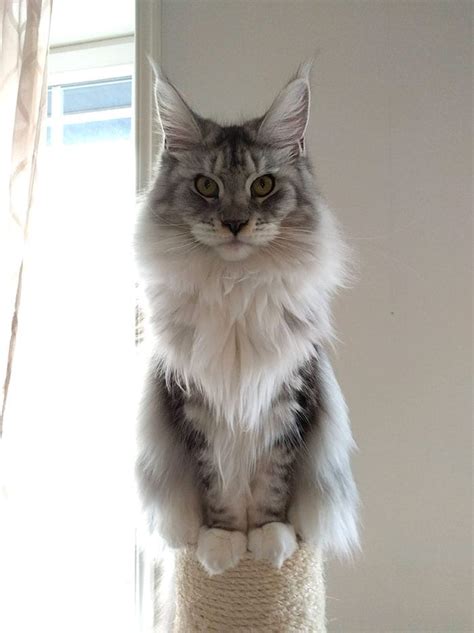
A Maine Coon’s insistent meows and gestures demanding outdoor access have captivated audiences online, showcasing the breed’s distinctive personality and communication skills.
A viral video featuring a Maine Coon cat named Walter has charmed the internet, depicting the feline’s persistent efforts to convince his owner to grant him outdoor privileges. The video, originally posted on TikTok by user @WalterTheMaineCoon, showcases Walter’s articulate meows and strategic nudges towards the door, highlighting the breed’s renowned intelligence and communicative nature. The clip has rapidly gained traction, amassing millions of views and sparking discussions among cat lovers about the best practices for accommodating a cat’s desire for outdoor exploration while prioritizing their safety.
The video opens with Walter standing near the door, emitting a series of distinctive meows that sound remarkably like conversational demands. He then proceeds to physically interact with his owner, gently nudging their leg and directing their attention towards the exit. According to the original TikTok post, this behavior is a daily occurrence, demonstrating Walter’s consistent desire for outdoor time and his learned method of communicating this desire to his human companion.
Maine Coons, known for their large size, gentle demeanor, and intelligence, often exhibit unique communication styles. Their vocalizations are diverse and expressive, ranging from chirps and trills to meows that can convey specific needs or desires. “They’re known for being very vocal and communicative,” explains Dr. Emily Carter, a veterinarian specializing in feline behavior. “This particular Maine Coon’s behavior is a classic example of how intelligent cats can be in expressing what they want.”
The breed’s history as working cats, initially used for controlling rodent populations on farms and ships in Maine, has likely contributed to their inquisitive and active nature. This inherent curiosity often translates into a strong desire to explore their surroundings, making outdoor access a highly coveted privilege for many Maine Coons.
However, allowing cats unrestricted outdoor access raises significant safety concerns. Outdoor cats are exposed to a variety of risks, including traffic accidents, encounters with other animals (both domestic and wild), exposure to diseases, and the potential for getting lost or stolen. Shelters and animal welfare organizations consistently caution against allowing cats to roam freely outdoors.
“While it’s natural for cats to want to explore, the risks associated with unsupervised outdoor access are substantial,” says Sarah Johnson, director of a local animal shelter. “We strongly advocate for indoor enrichment and supervised outdoor experiences to ensure the safety and well-being of feline companions.”
Recognizing the potential dangers, many cat owners are exploring alternative solutions that allow their feline friends to enjoy the outdoors safely. These options include building enclosed cat patios (catios), utilizing harnesses and leashes for supervised walks, and creating secure outdoor enclosures.
Catios, enclosed patios specifically designed for cats, provide a safe and stimulating outdoor environment. They can be attached to a window or door, allowing cats to access the space at their leisure, or they can be freestanding structures within a yard. Catios offer protection from predators, traffic, and other hazards, while still providing cats with fresh air, sunshine, and opportunities for environmental enrichment.
Harness and leash training allows cats to explore the outdoors under the direct supervision of their owners. This method requires patience and positive reinforcement, as cats need to be gradually acclimated to wearing a harness and walking on a leash. However, once trained, harness walks can provide a safe and controlled way for cats to experience the sights, sounds, and smells of the outdoors.
Secure outdoor enclosures, often constructed from wire mesh or netting, provide a larger and more natural outdoor space for cats to roam without the risk of escape or exposure to hazards. These enclosures can be customized to include climbing structures, scratching posts, and other enrichment items, creating a stimulating and engaging environment for feline residents.
The popularity of Walter’s video underscores the growing awareness of cat enrichment and the importance of providing feline companions with opportunities for mental and physical stimulation. As more cat owners recognize the benefits of enriching their cats’ lives, innovative solutions for safe outdoor access are likely to continue to emerge.
Veterinarians and animal behaviorists emphasize the importance of understanding a cat’s individual needs and preferences when determining the best approach to outdoor access. Some cats may be perfectly content with indoor enrichment alone, while others may exhibit a strong desire to explore the outdoors. Careful observation and experimentation can help owners determine what works best for their feline companions.
“Every cat is an individual, and their needs will vary,” explains Dr. Carter. “It’s essential to consider their personality, health, and environment when making decisions about outdoor access. The goal is to provide them with a stimulating and fulfilling life while minimizing the risks to their safety and well-being.”
The viral video of Walter the Maine Coon serves as a reminder of the strong bond between humans and their feline companions and the lengths to which cat owners will go to meet their pets’ needs. By prioritizing safety and exploring alternative solutions, cat owners can provide their feline friends with opportunities to enjoy the outdoors while ensuring their well-being. The ongoing dialogue surrounding cat enrichment and responsible pet ownership is a positive step towards creating a better world for cats and the people who love them.
The incident also underscores the broader debate within the pet-owning community about the ethical considerations of keeping animals indoors versus allowing them to roam freely. Advocates for indoor-only cats often point to the reduced risk of injury, disease, and premature death, as well as the potential impact of outdoor cats on local wildlife populations. Conversely, proponents of outdoor access argue that it is essential for cats’ physical and mental well-being, allowing them to engage in natural behaviors such as hunting, exploring, and socializing.
Finding a balance between these competing perspectives is a challenge that many cat owners face. The key, according to experts, is to prioritize the individual needs of the cat while also considering the potential risks and benefits of different approaches. This may involve providing a stimulating indoor environment, offering supervised outdoor access, or creating a secure outdoor enclosure.
The video of Walter has also sparked discussions about the importance of understanding feline communication. Cats communicate in a variety of ways, including vocalizations, body language, and scent marking. By paying attention to these signals, owners can gain a better understanding of their cats’ needs and preferences.
Walter’s persistent meows and nudges are a clear indication of his desire for outdoor access. Other common feline communication signals include purring, hissing, scratching, and rubbing. Understanding these signals can help owners to build stronger bonds with their cats and provide them with the care and attention they need.
In addition to the ethical and practical considerations of outdoor access, there is also a growing body of research on the benefits of cat ownership for human health and well-being. Studies have shown that owning a cat can reduce stress, lower blood pressure, and improve cardiovascular health. Cats can also provide companionship and emotional support, particularly for people who live alone or are experiencing difficult times.
The viral video of Walter the Maine Coon is a lighthearted example of the special bond between humans and their feline companions. It also serves as a reminder of the importance of responsible pet ownership and the ongoing efforts to create a better world for cats and the people who love them. As the conversation about cat enrichment and outdoor access continues, it is essential to keep the focus on the individual needs of each cat and the importance of prioritizing their safety and well-being.
The attention Walter is receiving is also influencing the popularity of the Maine Coon breed. Shelters and breeders are reporting an increase in inquiries about the breed as people are captivated by their intelligence, size, and friendly demeanor. The breed’s gentle nature and adaptability make them excellent family pets and companions. This increased interest can be a double-edged sword. While raising awareness is beneficial, it also runs the risk of encouraging irresponsible breeding practices.
Potential Maine Coon owners should thoroughly research breeders or consider adopting from a reputable shelter. Responsible breeders prioritize the health and temperament of their cats, conducting genetic testing to minimize the risk of hereditary diseases. Shelters often have Maine Coons or Maine Coon mixes looking for loving homes. Adoption not only provides a home for a deserving animal but also helps reduce pet overpopulation.
The discussion around Walter’s desire for outdoor time also highlights the evolving roles of pets in modern households. Pets are increasingly viewed as family members, with owners investing significant time and resources in their care and well-being. This anthropomorphism drives demand for higher-quality pet food, innovative enrichment products, and advanced veterinary care.
This shift in perspective also influences the way pet owners approach decisions about their animals’ lives. Instead of simply providing basic necessities, owners are increasingly focused on enriching their pets’ lives and providing them with opportunities to thrive. This includes considerations like social interaction, mental stimulation, and physical exercise.
The story of Walter the Maine Coon, in essence, resonates with a broader cultural trend of prioritizing the well-being and happiness of our animal companions. It’s a reminder that pets are not just possessions but sentient beings with their own unique needs and desires. By understanding and respecting these needs, we can build stronger bonds with our pets and create a more fulfilling life for them and ourselves.
The incident with Walter also indirectly sheds light on the increasing use of social media to raise awareness about animal welfare issues. Platforms like TikTok, Instagram, and Facebook have become powerful tools for sharing information about pet adoption, responsible pet ownership, and animal rights.
Animal shelters and rescue organizations frequently use social media to showcase adoptable animals and connect them with potential owners. These platforms also provide a space for pet owners to share tips and advice on pet care, fostering a sense of community and mutual support.
Social media campaigns can also be effective in raising awareness about animal welfare issues, such as animal cruelty, neglect, and the importance of spaying and neutering. By leveraging the power of social media, animal advocates can reach a wider audience and inspire positive change.
However, the use of social media for animal welfare advocacy also has its challenges. It is important to ensure that information shared on these platforms is accurate and reliable, and to avoid spreading misinformation or engaging in harmful stereotypes. It is also important to be mindful of the potential for compassion fatigue and to avoid overwhelming people with negative content.
Ultimately, the story of Walter the Maine Coon is a reminder of the complex and multifaceted relationship between humans and animals. It highlights the importance of responsible pet ownership, the need for ongoing dialogue about animal welfare issues, and the power of social media to raise awareness and inspire positive change.
The incident serves as a microcosm for broader discussions about animal rights and welfare. While Walter’s demands are relatively benign, the underlying principles apply to more serious issues, such as factory farming, animal testing, and the treatment of animals in entertainment. The question of how we treat animals reflects our values and our understanding of our place in the natural world.
As our understanding of animal cognition and behavior continues to grow, so too does our responsibility to ensure that animals are treated with respect and compassion. This requires ongoing dialogue, critical thinking, and a willingness to challenge our own assumptions and biases.
The viral video of Walter also highlights the importance of considering the environmental impact of pet ownership. Pets require food, supplies, and veterinary care, all of which have a carbon footprint. Responsible pet owners can reduce their impact by choosing sustainable products, supporting local businesses, and minimizing waste.
This includes considering the source of pet food, opting for eco-friendly litter, and reducing the use of single-use plastics. It also involves supporting animal shelters and rescue organizations, which play a vital role in reducing pet overpopulation and preventing animal suffering.
The story of Walter the Maine Coon is a small but significant example of how our interactions with animals can shape our values, our beliefs, and our understanding of the world around us. It is a reminder that even the smallest actions can have a big impact, and that we all have a role to play in creating a more just and compassionate world for all living beings.
FAQ:
-
Why is the Maine Coon named Walter so popular online? Walter, the Maine Coon, has gained popularity due to his very expressive and seemingly intentional meows and gestures indicating his desire to go outside. This communicative behavior, characteristic of Maine Coons, resonates with viewers who appreciate the breed’s intelligence and personality. “They’re known for being very vocal and communicative,” explains Dr. Emily Carter, a veterinarian specializing in feline behavior, highlighting the breed’s reputation.
-
What are the main concerns about letting cats, like Walter, roam freely outdoors? The primary concerns involve safety. Outdoor cats face risks such as traffic accidents, fights with other animals, exposure to diseases, getting lost, or even being stolen. Sarah Johnson, director of a local animal shelter, emphasizes this: “While it’s natural for cats to want to explore, the risks associated with unsupervised outdoor access are substantial. We strongly advocate for indoor enrichment and supervised outdoor experiences.”
-
What are some safer alternatives to allowing a cat unrestricted outdoor access? Several safer alternatives exist. These include building enclosed cat patios (catios), using harnesses and leashes for supervised walks, and creating secure outdoor enclosures. These options allow cats to experience the outdoors while minimizing potential hazards.
-
What makes Maine Coons different from other cat breeds in terms of their behavior and needs? Maine Coons are known for their large size, gentle demeanor, intelligence, and communicative nature. They often exhibit unique vocalizations and a strong desire to explore, stemming from their history as working cats. This breed-specific trait necessitates owners to find ways to satisfy their curiosity while ensuring their safety.
-
How can understanding feline communication improve the relationship between cats and their owners? Cats communicate through vocalizations, body language, and scent marking. Paying attention to these signals allows owners to better understand their cat’s needs and preferences. Walter’s meows and nudges are a clear example of a cat expressing a specific desire, which owners can then address appropriately. Understanding these signals strengthens the bond and ensures the cat’s well-being.









